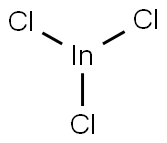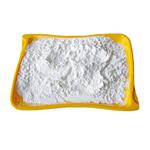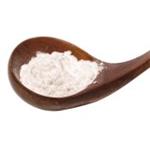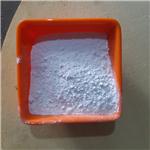Description
Indium chloride is a useful catalyst for aqueous organic reactions including C-C bond formation, aldol reaction, Friedel-Crafts acylation, Diels-Alder reaction and reduction1-4. It is an efficient, mild, Lewis acid for organic synthesis. It is an efficient catalyst for thioacetalization and its chemoselectivity. It can also catalyze the enantioselective ring-opening of meso-aziridines with thiols. Moreover, it can act as a highly efficient catalyst in water for the preparation of furyl glycosides.
Chemical Properties
white crystalline powder
Hygroscopic. Decomposes in
water to InCl3 and In. M.p. 235°C; decomposes below the m.p.,
apparently to InCl3 and InCl; b.p. ~570°C; d 3.65. Rhombic
crystals.

Uses
Indium chloride is used as catalyst for aqueous organic reactions including C-C bond formation, aldol reactions, and reductions and for organic synthesis. In electroplating using a solution of the salt with dextrose and NaCN.
Production Methods
According to Klemm, metallic In is oxidized in InCl3 in a stream of Cl2, which has been carefully dried with concentrated H2SO4 and P2O5. A thoroughly dried quartz apparatus whose components have been fused or connected by ground joints is used. Chlorination proceeds rather vigorously at first, with a pale glow, and it proceeds through the mono- and dichloride steps. These compounds are melts. The end product of the chlorination, InCl3, sublimes around 600°C as lustrous spangles which appear on the walls of the receiver. The Indium chloride (LnCl3) may be purified by subliming in a stream of N2 (or CO2) to which some Cl2 has been added. The sublimate can cool in a stream of inert, Cl2-free gas to remove excess chlorine.
General Description
Indiumchloride (InCl
3) is an indium halide that is a Lewis acid in a variety of organic reactions.
reaction suitability
reagent type: catalyst
core: indium
Purification Methods
The anhydrous salt forms yellow deliquescent crystals which can be sublimed at 600o in the presence of Cl2/N2 (1:1) [does not melt]. It is resublimed in the presence of Cl2/N2 (1:10) and finally heated to 150o to expel excess Cl2. It is soluble in H2O and should be stored in a tightly closed container. [Baxter & Alter J Am Chem Soc 55 1943 1933.]






